Taiwan's Telecom Industry Seeks Promising Land in WiMAX
2008/07/29 | By Ken LiuTaiwan has traditionally been known as a follower in wireless technology-a position that once consigned it to a peripheral role in mobile-technology forums and the base-station equipment market. With the rise of the WiMAX era, however, Taiwan's wireless communications sector is finally taking center stage.
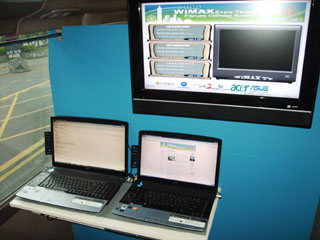
WiMAX Forum President Ron Resnick describes WiMAX (Worldwide Interoperability for Microwave Access) as " the first technology that allows true mobile Internet speed wherever you go wireless."
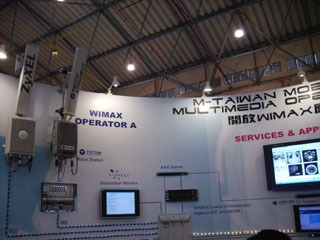
Considered to be the fourth-generation of mobile Internet-connectivity technology, WiMAX is strongly backed by technology heavyweights such as Intel, Google, Spring Nextel and Time Warner thanks to its seamless connectivity quality even at high traveling speed.
Taiwan's central position in the WiMAX industry was underscored early last month, when Taipei hosted the world's first WiMAX technology fair-WiMAX Expo. About 60 WiMAX solution providers, among them Intel, Alcatel-Lucent and Motorola, displayed their latest technology at 250 booths. The exposition was held in conjunction with the first WiMAX Operator Summit, during which WiMAX operators from the world exchanged views and experience in WiMAX development and deployment.
Taiwan's government is determined to develop the island into a world powerhouse for WiMAX applications and equipment. ROC President Ma Ying-jeou has pledged to push the Taipei City Government to equip the Taipei Mass Rapid Transit (MRT) system with WiMAX network as soon as possible, aiming to make Taiwan a world role model for wireless broadband connectivity.
In 2005, 6he Taiwan government chose WiMAX as the focus of its "Mobile Taiwan," or "M-Taiwan," next-generation mobile technology plan. The M-Taiwan plan aims to deploy a seamless broadband environment for Internet connectivity across the island. WiMAX was chosen because it could help local IT manufacturers break into global market for base-station equipment, which has been dominated by the Western suppliers.
"WiMAX is a budding, high-potential market now," says John Hsuan, chairman of the Taipei Computer Association's WiMAX committee. "This gives Taiwanese manufacturers a good chance to compete with international heavyweight telecom-solution providers on equal terms. Taiwan is much better poised to develop in the WiMAX industry than it was to enter the semiconductor industry 30 years ago," he adds.
From CPE to Base Stations
B.C. Ho, head of the Institute for Information Industry's (III's) Networks and Multimedia Institute, notes that as WiMAX is an open architecture, it offers Taiwan's telecom-equipment suppliers a good chance to migrate from consumer-premise products to base-station gear and wireless chips. The government-backed institute has transferred WiMAX base-station and chip technology to the private sector.
Taiwan accounts for 90% of the global market for Wi-Fi consumer-premise equipment (CPE), but it has not been able to grab a significant slice of the market for base-station equipment, which is about twice as valuable as the CPE market.
The M-Taiwan plan aims to provide wireless Internet access to eight million subscribers, improving Taiwan's international ranking for mobile Internet access and the international competitiveness of its cities, as well as attaining the goal of helping Taiwan export not only equipment but also system solutions. Over the past three years, the government has invested over US$200 million in the plan, mostly for laying broadband networks, establishing capability of verifying interoperability between different WiMAX equipment, and financing government-back institutes to develop WiMAX technology. "WiMAX represents next growth engine for Taiwan's electronics industry," says Economics Minister Yiin Chii-ming. "The government hopes Taiwan will become the world's largest WiMAX industry base and a global leader in WiMAX technology deployment," he adds.
The WiMAX Forum has approved two certification laboratories in Taiwan, the largest number in a single economy. The forum's four other certification laboratories are each running in mainland China, South Korea, Spain and the United States. The forum is a non-profit organization formed to certify and promote the compatibility and interoperability of WiMAX products. "Taiwan has been a hotbed for the development of wireless technology, and now as one of the premier champions of WiMAX through its commitment to driving the technology and products forward," Resnick said at the WiMAX Operator Summit when mentioning why the forum chose the island as a base for the forum's labs.
Faster Than a Speeding Bus
Accredited in June 2007, Advance Data Technology (ADT) Corp. is the first WiMAX Forum-endorsed laboratory in Taiwan for certifying fixed and mobile WiMAX equipment. Early this year, the forum selected TTC-CCS (Telecom Technology Center-Complaint Certification Services) its second designated certification lab in Taiwan for fixed and mobile WiMAX equipment. "This is a positive step to ensure the capacity to answer the demand for WiMAX Forum-certified testing for the Taiwanese industry and in the Asian market," said Resnick.
The industry's first WiMAX Forum-endorsed application lab, the M-Taiwan WiMAX Application Lab (MTWAL), was opened in 2007 by the government-backed Industrial Technology Research Institute (ITRI). The lab is designed to be an open environment where innovators from around the globe can develop and test new WiMAX applications covering categories such as Voice over Internet Protocol (VoIP) and entertainment.
"This new application lab, supported by the local industry and administration, is a stellar example of the global readiness of this region for the innovations that anytime, anywhere broadband Internet access of WiMAX technology will spawn," commented. Resnick.
ITRI unveiled the lab early last month with a demonstration of live Internet connectivity with 3G mobile phones on a bus moving at 50 kilometers-hour along a section of a highway near its headquarters in Hsinchu covered by six WiMAX base stations. The technology proved to be highly reliable and seamless.
ITRI President John-see Lee pointed out that WiMAX technology would upgrade wireless Internet-connected cities and bring about new opportunities. He noted the laboratory can carry out tests on new services, new applications and new tools.
Lee said his organization would aggressively develop new WiMAX application technology at the laboratory. He added that the institute has developed some IEEE802.16e-2005 solutions for multi-input/output radio frequency, mixed signal and base-band circuits. These solutions have won dozens of patents worldwide and can be applied to notebook computers and handheld devices.
The institute recently announced it would work with NTT/NTT-BP of Japan, Conning of the United States and Zyxel Communications of Taiwan to carry out the world's first field test of WiMAX-based Internet connectivity on a high-speed railway system and complete an integrated test by the end of this year. France installed satellite-based Internet-connectivity on its TGV system at the end of 2007, and Japan said it would introduce WLAN-based connectivity on the Shinkansen (bullet train).
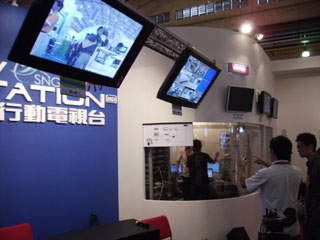
Taiwan Calling
Impressed by Taiwan's WiMAX endeavor, Nortel Networks Corp. opened a WiMAX certification laboratory in 2006 to test consumer-end equipment and handsets. This June, NEC, Japan's No.1 manufacturer of computer and telecommunications equipment, opened a laboratory in Taiwan to test interoperability of different WiMAX systems and develop WiMAX systems.
Motorola plans to open its first WiMAX interoperability testing laboratory in Taiwan, according to Simon Leung, president of Motorola Asia Pacific. "Taiwan's complete WiMAX ecosystem inspires us to consider opening the lab here," he stresses. Leung notes that Taiwan is the world's biggest supplier of notebook computers and networking equipment, which will be eventually embedded with WiMAX modules. "Testing these products in Taiwan will help accelerate development of Taiwan's WiMAX industry," he adds.
Early this year, Alcatel-Lucent announced it would work with the Ministry of Economic Affairs to open an interoperability testing laboratory in Taiwan.
A good testing environment is an advantage to equipment development and service deployment. The MIC expects that the M-Taiwan plan alone will drive the private sector to invest US$3 billion or so in the WiMAX industry by 2012. Taiwan's six WiMAX licensees-First International Telecom (FIT), Weita Cable TV System Co., Ltd., Far EasTone Telecom, Global Mobile One, Tatung InfoComm, and Vmax Telecom-are expected to pour a combined US$1 billion into equipment, an amount trailing their US counterparts.
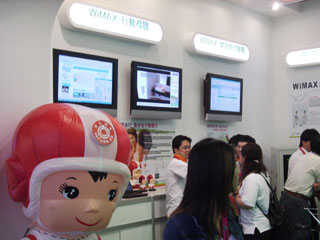
At present, Taiwanese content developers and WiMAX-service providers are competing to develop niche applications in preparation for the official launch of WiMAX services by most of the six licensees next year.
During the five-day WiMAX Expo FIT offered a peek at WiMAX embedded notebook computers on shuttle buses to and from the exposition hall and a hall few kilometers away at the Computex Taipei 2008 information-technology trade show. Even at a speed of 80 kilometers per hour, the download link on the bus maintained at 3-megabits per second, slowing down from 7Mbps connectivity at around 30 kilometers per hour. "The connectivity is seamless," pronounced one visitor. FIT will offer trial WiMAX operation in August this year in seven districts in Taipei City with 88 base stations.
New Applications
Tatung InfoComm will roll out a health care via WiMAX service. The application allows physicians to monitor in real-time physical conditions like blood pressure and blood sugar via teleconferencing links with senior citizens in remote regions. "The application allows physicians to diagnose patients over the Internet," said a Tatung sales representative at the WiMAX Forum.
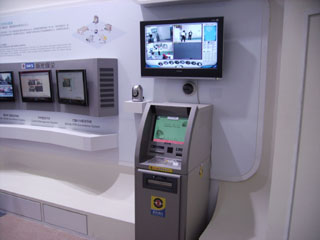
The Taipei City Government will introduce an application this or next month that allows citizens to report potholes on the city's roads with GPS and their mobile devices embedded with digital camera. "Once the information such as photos, location and type of case has been received, the city government can more effectively respond," said a city government official promoting the application at the forum.
The United Daily News (UDN) Group will offer an application that allows consumers to search for restaurants and shops near the Taipei MRT lines on their WiMAX or Wi-Fi mobile phones. "We have signed up around 200 businesses, mostly restaurants, and we will initially promote the application to residents in the city center," said a planning specialist of the group at the forum.
A similar application as UDN's will come from ETMobi, a TV shopping channel, which will offer consumers a collection of products from 2,500 suppliers to pick on their WiMAX phones. "We are pioneering TV shopping via mobile phone," said a sales specialist.
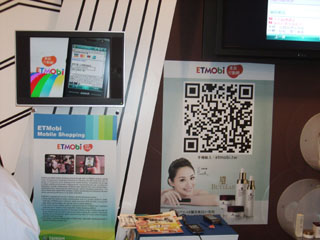
China TV Co. (CTV), a leading wireless TV company in Taiwan, plans to replace satellite news gathering (SNG) systems with WiMAX network as the major backbones for beaming real-time news pictures to its headquarters to reduce the transmission costs. "SNG investment is quite expensive. Our company will set up 27 WiMAX backbones throughout the island, with a 50-kilometer transmission range," said a CTV specialist at the trade fair.
At the fair, notebook-computer supplier Asustek Computer demonstrated WiMAX-embedded notebook computers, standalone WiMAX card, WiMAX routers, WiMAX modem and WiMAX-enabled Eee PC. The Eee PC is installed with Intel Atom processor. "Our product strategy is standalone cards come first and WiMAX embedded notebooks come later because the cost of computer embedment won't come down before services are available. It is similar to what happened when the Internet took-off 10-some years ago. The standalone PCMCIA card was an interim device before Ethernet LAN cards were built into computers," Yi Hsieh, associate vice president of the company's sales and marketing section, said.
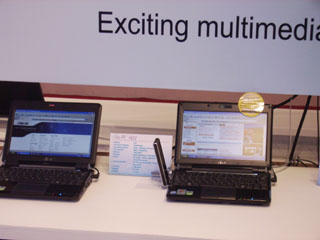
Most of the six licensees will begin to offer services next year, when the technology for volume-production of base stations is expected to mature. "Massive-scale installations of base stations will be possible next year when the unit price of the equipment drops to NT$1.5 million [US$50,000] from the current NT$2.5 million [US$83,000]," says C.Y. Wu, chairman of FIT.
So far, Taiwanese telecom-equipment suppliers including Tecom, Zyxel Communications Corp. and Alpha Networks Inc. have introduced WiMAX base stations.
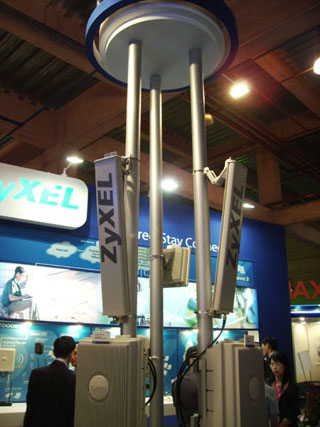
Tecom is focusing on macro and micro types of the equipment, Zyxel is developing femto and pico equipment, and Alpha is developing pico equipment.
The MOEA estimates the Taiwan generated NT$2.78 billion (US$92 million) last year from WiMAX CPE, accounting for 20% of the global total. WiMAX base-station revenue amounted to NT$100 million (US$3.3 million) in 2007, comprising around 1% of the global industry. The ministry projects that Taiwan will grab 90% of the global WiMAX CPE market and 35% of global market for WiMAX base stations by 2015, with revenue in the two segments reaching NT$270 billion (US$9 billion) and NT$38.3 billion (US$1.2 billion) at that time. Tecom has reportedly landed orders from some European telcos for base-station equipment.
The WiMAX Forum estimates that there will be 133 million WiMAX users worldwide by 2012, with Asia Pacific region leading the market with 60 million users. North America will come second with an estimated 22 million users, followed by Europe and the Middle East/Africa.
Currently there are over 260 WiMAX operators worldwide. The number is expected to rise to 538 by 2012, with the Middle East/Africa region anticipated to account for the highest number, followed by Europe, Central and South America, the Asia Pacific region, and North America.
Big League Backer
"In some countries, WiMAX is already in play," says Lonnie McAlister, product line manager of the Taiwan branch of Intel Microelectronics Asia Ltd., in an interview with CENS. "WiMAX, for instance, is available in South Korea today, with commercial launch across the entire country. There are over 260 WiMAX network deployments around the world today, some of them commercial and some of them still in the trial phase."
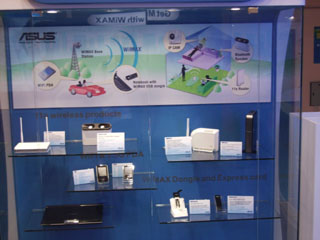
When asked why WiMAX is so enticing, McAlister says: "WiMAX provides a low cost data rate. There is less IP structure, no royalties or low royalties [for WiMAX]. Everyone can play because everyone has to go and get standard certification. It goes through the industry certification process. So, that means a lot people can compete and drive the cost down. That's what WiMAX promises to bring. You can't get that in 3G and you probably won't get that in LTE either because it still has an IP royalty structure. A lot of incumbencies today are migrating to LTE, but LTE is under a lot pressure from WiMAX because WiMAX can deliver broad bandwidth that 3G can't provide."
At WiMAX Expo 2008, McAlister's company promoted the Intel Echo Peak and Intel Centrino Atom WiMAX technologies. Intel Echo Peak is a WiMAX/Wi-Fi wireless module that has been built into Asustek's Eee netbook and notebooks from Acer, Lenovo and Fujitsu. "This is really a big display of working Echo Peak units in the world. WiMAX promises to deliver high bandwidth data applications. So, you need devices to take advantage of that bandwidth. These are the devices that we believe are the right for the job. They are all based on our next-generation silicon called Centrino Atom Processor Technology," he said.
Intel plans to introduce Centrino II chipset some time this month. According to McAlister, the second-generation WiMAX chip is higher performance, lower power consumption than the first-generation chipset. "WiMAX is not just about the solution itself, but about the technology. All PC makers now are interested in WiMAX and testing WiMAX and have even shipped in volume production. The problem is the networks are not ready yet. When the networks are ready we will enable everyone who wants to ship into those markets with the WiMAX Centrino II platform," he said.
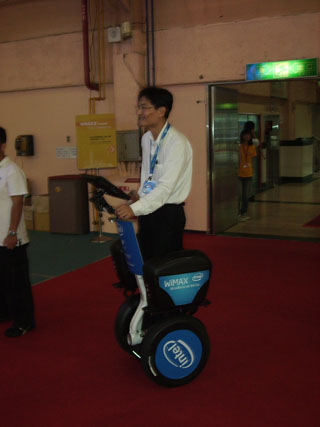
McAlister's company impressed visitors with the company's "true mobile WiMAX application" by employing two Segways equipped with a tablet PC to demonstrate how it worked. On the PC is a location map of Taipei city and the Segways are represented by two bubble marks. They were moving around the hall with cameras that showed where the Segway drivers were. The system connected to the Motorola Fitel network through a WiMAX network. From there it was routed through Fitel's central server and back again. The server connected to a hardwire Internet link and went out over the Internet and came back to the PC over Ethernet. "On the Segway demo we can get access to the Internet wirelessly. It is a mobile Internet."




